Butterfly Gardening
 Yellow Zinnia with Buckeye Butterfly in a backyard garden |
We love watching butterflies wherever our travels take us across the country. When at home, we enjoy butterfly gardening in the backyard, and designing our landscape to provide food and shelter for a variety of butterflies.
The Needs of the Butterfly
Butterflies, like birds and other animals, need food, water, and shelter, the basic necessities of life. In addition, butterflies like direct sunlight, and heat. They are cold blooded creatures, and thus need warm resting places such as flat stones, or bricks.
Butterflies use sunlight to regulate their body temperature. They need sunlight to keep themselves warm, but the outside temperature can also become too hot for them.
A good butterfly garden should provide both sunny places and shady places where butterflies can cool off while they eat. They also need shelter from wind, and inclement weather.
| Butterfly Gardening Blog 2024 ... what we are growing in our gardens this year |
We often provide a shallow pan or plate filled with sand, small rocks, soil and water, and perhaps manure. Butterflies won't typically get their bodies wet in the water, but don't mind getting their feet wet! This process is called "puddling". Butterflies can extract dissolved salts from the mud.
Food Sources
There are two different functions that plants serve for butterflies. Nectar plants, and host plants on which butterflies can lay their eggs on. Different species of butterfly prefer different flowers.
Butterflies only lay eggs on the plant that the caterpillar will eventually eat, usually on the underside of leaves. When planning your backyard butterfly garden, consider providing both nectar plants and host plants.
Overripe Fruit
Rocks set among nectar plants provide a great place for butterflies to rest, and warm up! |
While most butterflies prefer flowers, some don't. Overripe, even fermenting fruit will also draw many butterflies. We use a shallow pan filled with slices of melon, overripe bananas, peaches, or grapes. Just make sure that you relocate the pan to a safe place at night to avoid curiosity seekers such as raccoons.
We often have Mourning Cloaks, Red Admirals, Question Marks, Red Admirals, Red-Spotted Purples, Zebra Longwings and others enjoying our leftover fruit.
Puddles and Stones
Male butterflies sometimes gather together at mud puddles. This "puddling" process is a way to sip needed amino acids and salt. We dig shallow depressions in our beds, sink a small saucer or pan, fill it with sand, dirt or small pebbles, and keep it moist and wet.
Our backyard landscape also includes a generous supply of stones and flat rocks. These absorb energy from the sun, and provide a warm basking place for butterflies.
Our Home Landscape
Our landscape features a number of different ecological environments. It is in the country, and backs up to hundreds of acres of forest and wetlands, with nearby fields and pastures.
 View of part of our home butterfly gardens! |
We've included in our landscape several types of Lantana (45 plants at last count!), Zinnias, Pentas, Salvia, Batface Cuphea, Verbena, Coreopsis, Fire Bush and other butterfly-friendly plants, annuals and perennials.
We also plant lots of dill and fennel seeds to provide food sources for black swallowtails. The woods nearby provide additional butterfly host plants such as Sassafras, Spicebush, Hercules' Club, Sweet Bay and others.
Other landing and feeding spots include (depending on the season) dozens of Azaleas, Pansies, Impatiens, Knockout Roses, Creeping Phlox, Daffodils, Hydrangeas, Portulaca and Gladiolas.
Our landscape also caters to hummingbirds. We often have over 40 Ruby-throated hummingbirds on our feeders at one time during the fall migration southward.
At times we are also blessed with several brightly colored Baltimore Orioles on our feeders!
We are proud to be a Certified Monarch Waystation. By creating a Monarch Waystation you can assist in Monarch butterfly conservation and help the preservation of the species.
What We Grow in Our Butterfly Garden ... and Some Suggestions for You!
Included below is a discussion and photos of our favorite butterfly plants in our home landscape! Hopefully, some of these will work for you in your butterfly garden, or stimulate some ideas that you might pursue.
Variegated Fritillary  |
American Lady 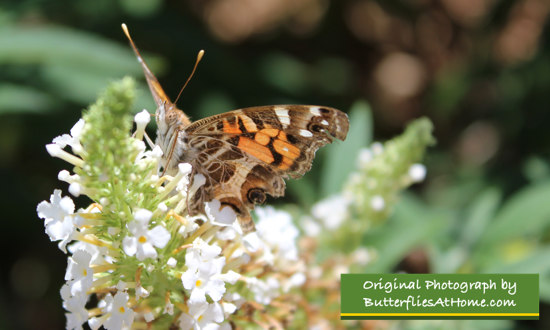 |
Lantana
 |
We love lantana, as evidenced by the fact that we have over 45 plants growing now, consisting of several varieties, from yellow to white to red to orange.
Lantana is super heat tolerant, and are typically pest and disease free. It does best in a minimum of 6 hours of direct sun a day.
Lantanas are perennials in warmer climates, and will flower in full sun or light shade, preferably in well-drained soil. As semi-desert natives, they bloom best when not overfed or over watered. Lantanas are frost proof to about 25 degrees F; when they do freeze, in milder climates they will spout from their base in the spring.
| Julia Heliconian |
Lantana ... and One Ant!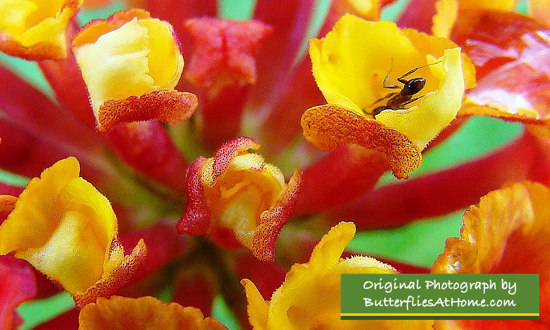 |
Sulphur on Lantana  |
Pearl Crescent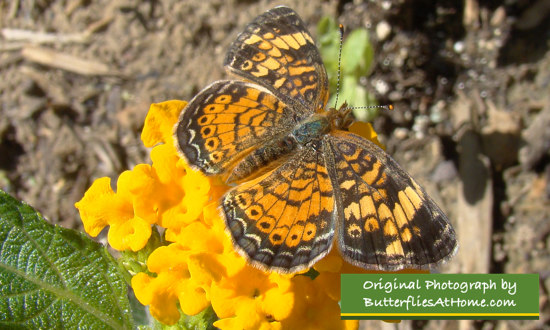 |
Zinnias
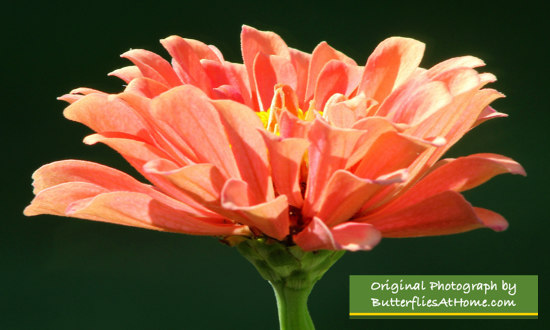 |
Zinnias are among the favorite flowers in our landscape. They are easy to grow from seed, provide all sorts of colors in the landscape, make perfect long-term cut flowers for inside .... and butterflies love them!
We grow California Giants from seed each year for those areas that are suited for these big 3-4 foot plants ... their blooms are spectacular, up to 4-5 inches in diameter! And we buy Dreamland Hybrid Zinnias seeds every year from Park Seed Company. These germinate quickly, and produce 2" blossoms on short, compact 12" plants ... ideal for spaces where we don't want height.
A large variety of butterflies enjoy our zinnias ... we have included several photos below.
Budding California Giant Zinnia 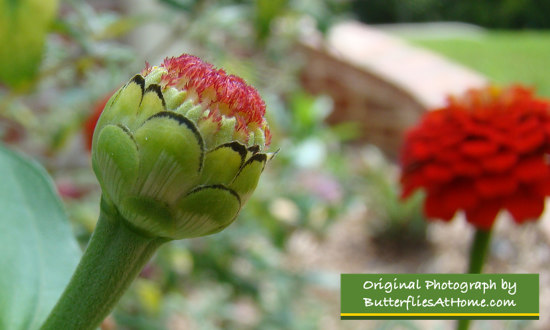 |
Painted Lady on Giant Zinnia  |
Gulf Fritillary 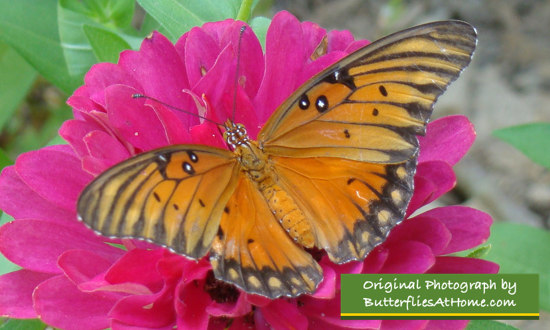 |
Long-tailed Skipper |
Giant Swallowtail 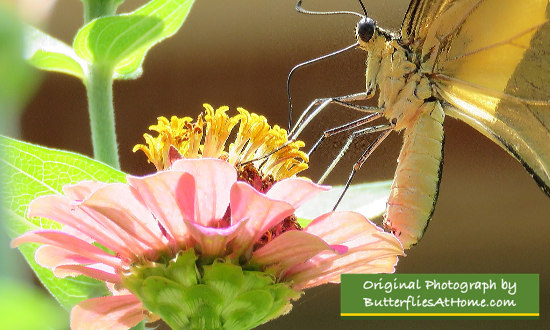 |
Silver-spotted Skipper  |
Female Tiger Swallowtail 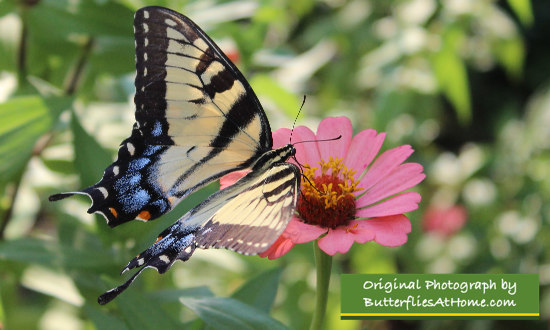 |
Fiery Skipper on Zinnia |
Pipevine Swallowtail 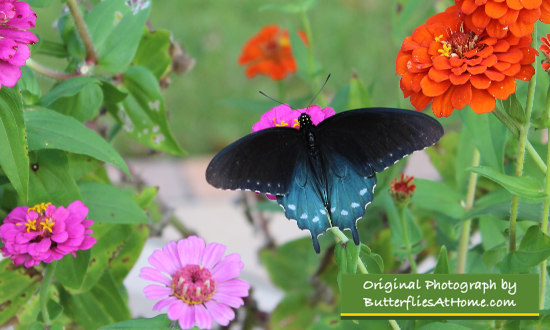 |
Giant Swallowtail Couple 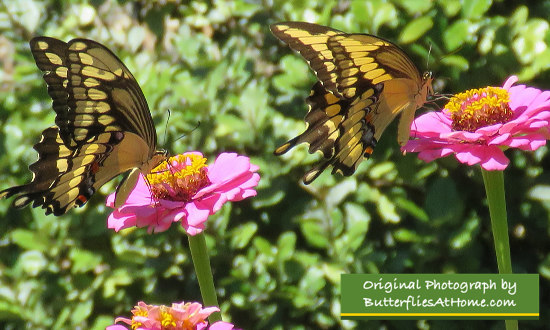 |
Verbena
Verbena is a part of our home landscape every year, and the butterflies love it!
We use several different colors, including orange (shown below), red, purple and pink. They are fairly cold tolerate and most years return after winter.
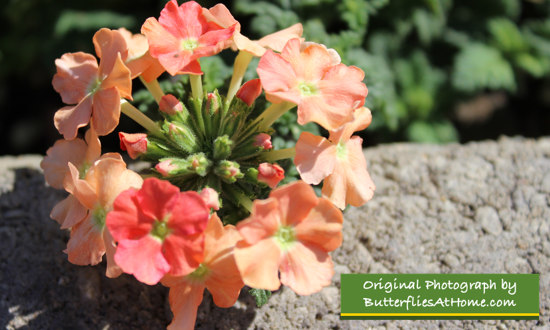 |
Purple Verbena 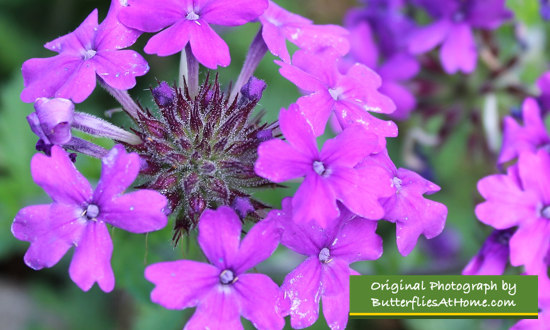 |
Tiger Swallowtail on Verbena 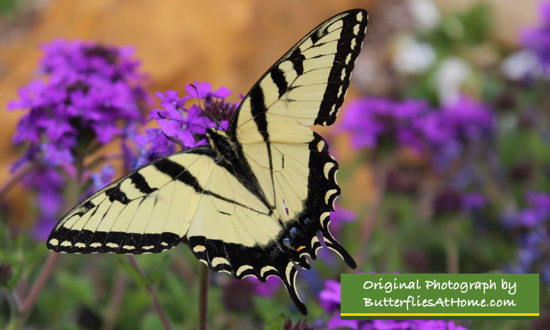 |
Dianthus
Dianthus is easy to grow, and comes in many colors and varieties, some sold colors like the red shown below, and mixed shades. They are also known as "pinks", and "Sweet William" due to their spicy fragrance. The plants are compact, typically 6"-12" in height.
Depending on location, Dianthus may be grown as a hardy annual, biennial or perennial. They can bloom all year, are fairly cold tolerant and come back quickly in the spring from last year's growth.
Brilliant red Dianthus in the landscape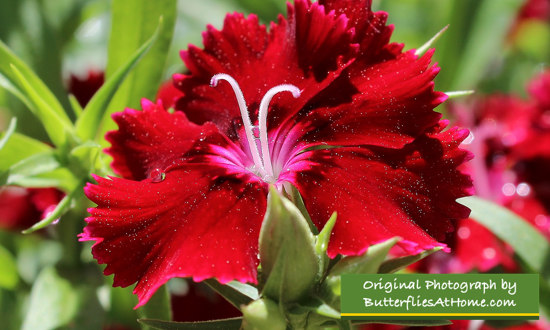 |
Dianthus 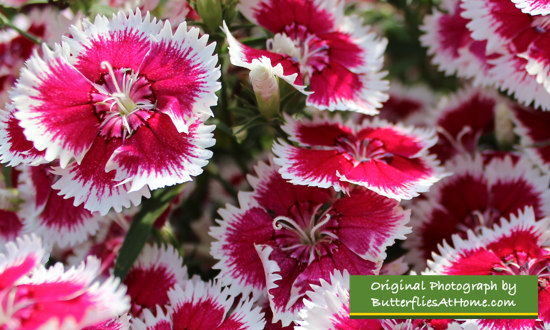 |
Silver-spotted Skipper |
Pentas
Pentas are a favorite of butterflies, and we make sure we plant various colors each spring: red, pinks and solid whites!
These star-shaped flowers feature five petals, and are sun lovers. Sometimes they are known as the “Egyptian Star Flower”.
Gray Hairstreak on Pentas |
Red Admiral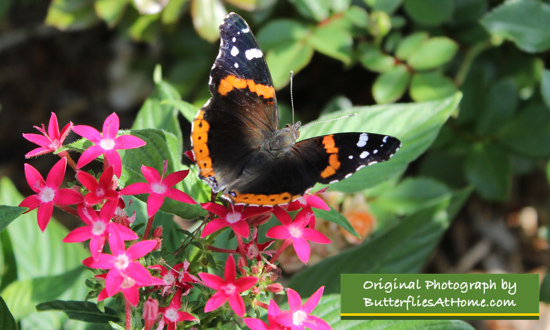 |
Passion Flower Vine (Passiflora)
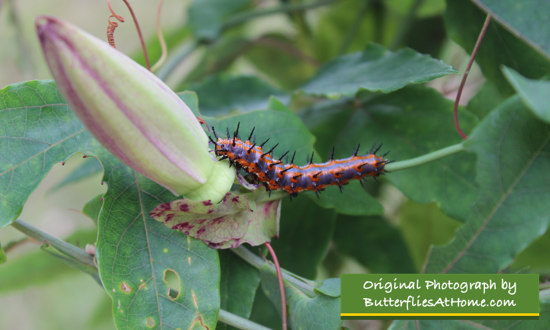 Gulf Fritillary caterpillar on Passion Vine |
The Passion Flower is a perennial vine producing delicate 3-5" flowers, and a host to a number of butterfly species. They are typically light blue or lavender in color, and a great climber on fences or trellises.
There are nearly 500 varieties of Passiflora in the world, with a common variety being Passiflora incarnata, often called Maypop. Unfortunately, a couple of species (the tropical red-flowered and even some of blue-flowered) are actually toxic and deadly to caterpillars. So do your research before purchasing your passion vine!
The Passion flower species are revered by many for their extraordinarily intricate blooms, which have become symbols of the Passion of Christ's crucifixion. Its name orginates from Roman Catholic priests of the late 1500s when they realized the flower told the story of Christ's passion, suffering and death. The flower's five petals and five petallike sepals represented the 10 apostles who remained faithful to Jesus throughout the Passion. The circle of hairlike rays above the petals suggested the crown of thorns that Jesus wore on the day of His death.
The vines are a host for a number of butterflies, including the Gulf Fritillary, Variegated Fritillary, Julia and Zebra Longwing.
The native Passion Vine here in Texas is agressive, putting up shoots from underground roots several feet from the original vine. The vines will produce a hollow, green egg-shaped fruit that produces a loud popping noise when crushed, hence the common name of "Maypop".
Purple Passion Vine 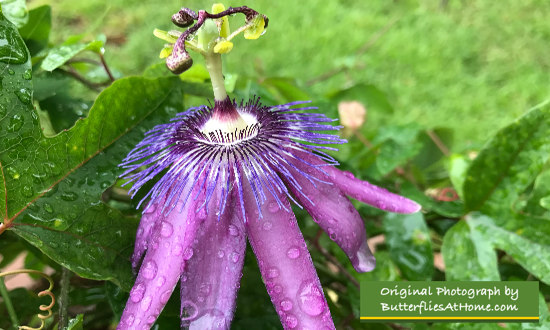 |
Red Passion Flower (non-toxic variety) 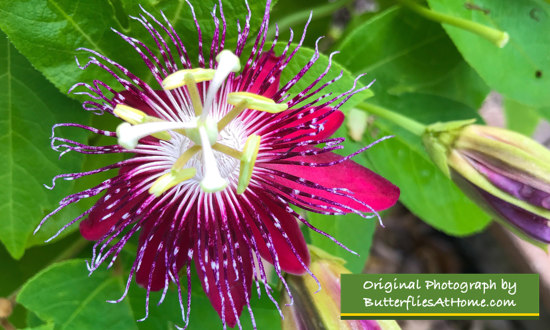 |
Native Texas Passion Vine Flowers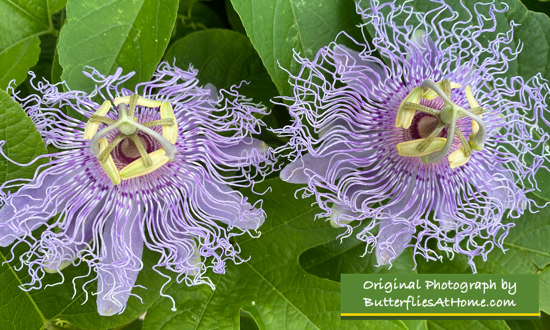 |
The Maypop ... fruit of the Native Passion Vine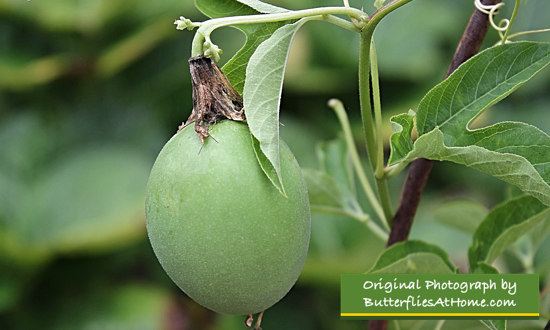 |
Salvia and Sage
Pink Salvia  |
Black & Blue Salvia 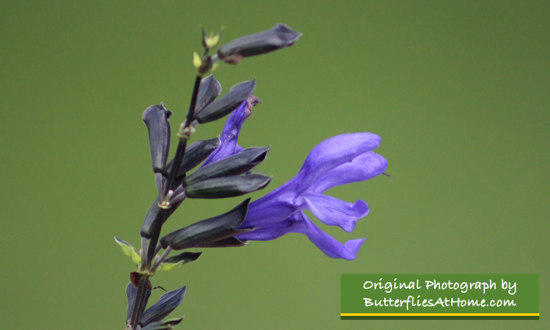 |
Hot Lips Salvia  |
Scarlet Sage  |
Hibiscus
We have grown hibiscus for years, actually decades! Their giant 6-8" blooms provide huge amounts of various summer color. Here in Upper East Texas, the winters are too harsh for their suvival, so we grow them more like an annual, replacing them with new plants each year.
Yellow Hibiscus with Red Throat 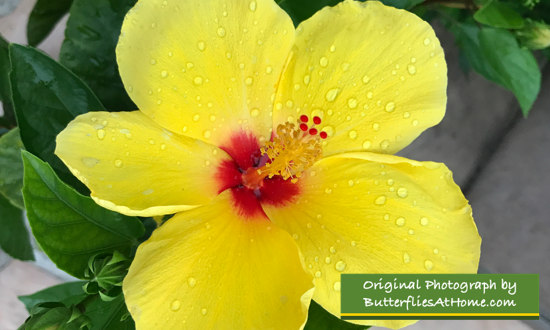 |
Delicate Pink Hibiscus  |
Hydrangea
Hydrangea 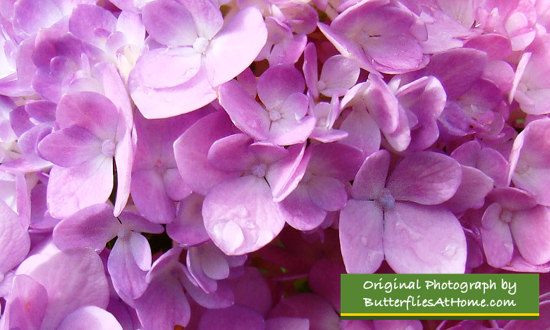 |
Buckeye on Hydrangea 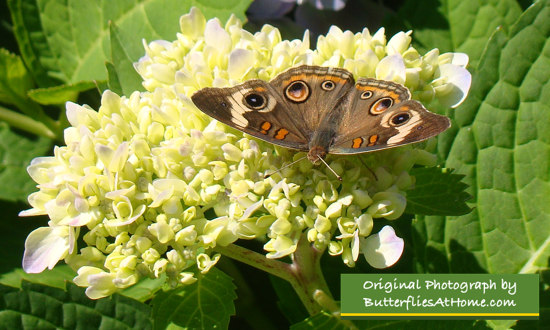 |
Pansies
Pansies have been a favorite of ours for decades! We plant them in mid-October, they survive even brutal winters and snow, and last until May when the heat returns. They add valuable color to the landscape through drab, dark winter days, and provide joy as cut flowers inside!
Happy White Pansy 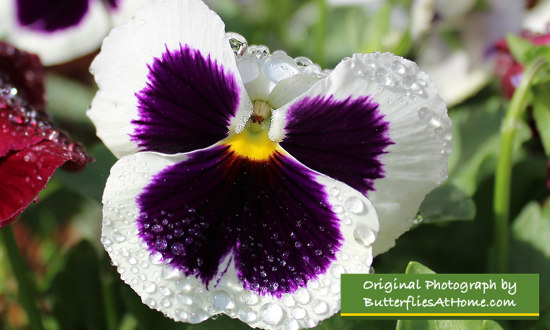 |
Black Swallowtail on Pansies  |
Portulaca
Portulaca |
Skipper Enjoying Portulaca  |
Roses
Pink Rose Bud in Morning Dew 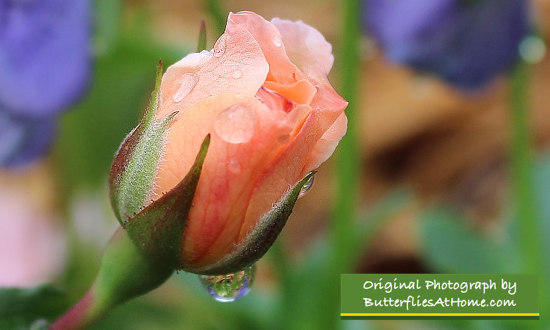 |
Yellow Rose Bud Waiting to Open 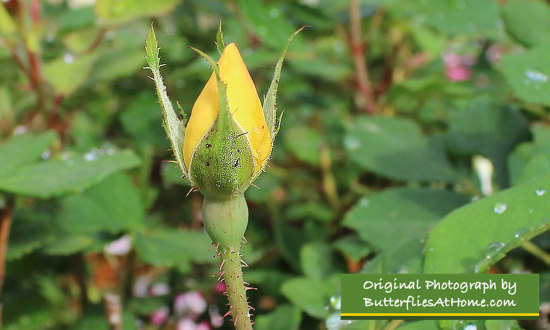 |
Delicate Pink Roses  |
Pair of Skippers on Roses 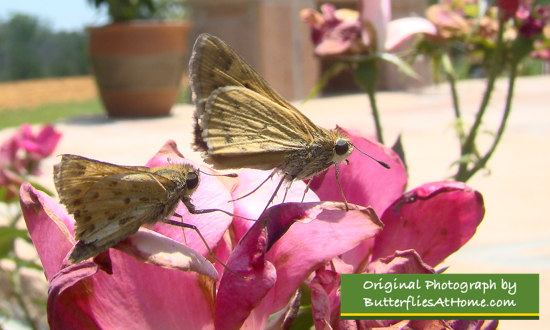 |
More Flowers in our Landscape!
Batface Cuphea 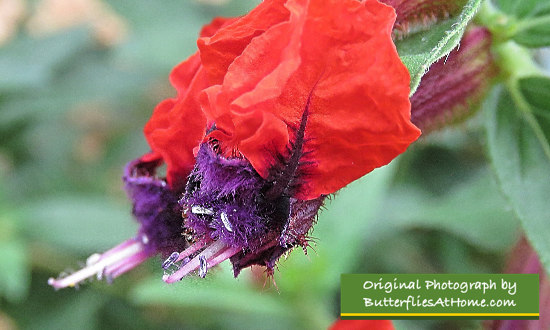 |
Azaleas & butterfly yard art!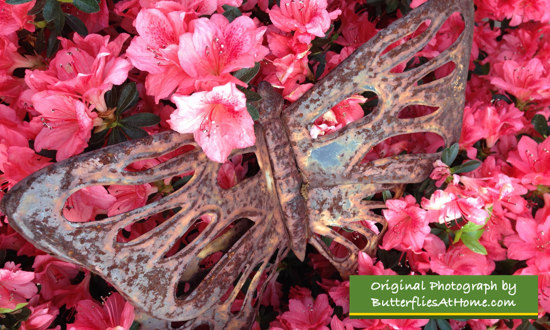 |
Bougainvillea 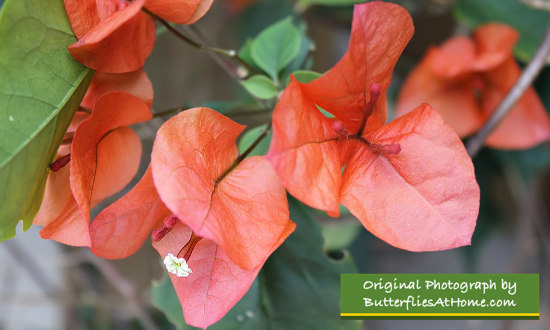 |
Crepe Myrtle  |
Dill ... with Swallowtail Eggs!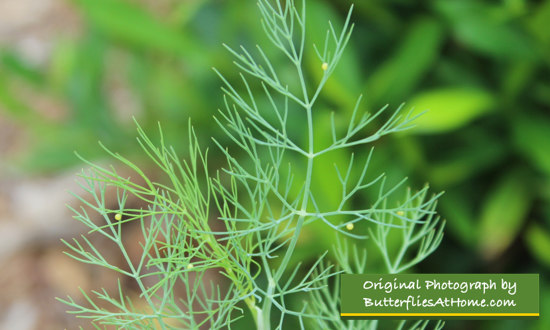 |
Firecracker 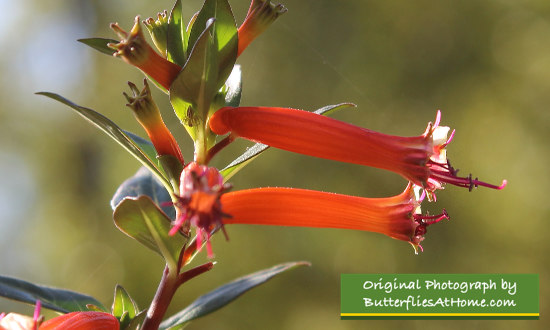 |
Geraniums 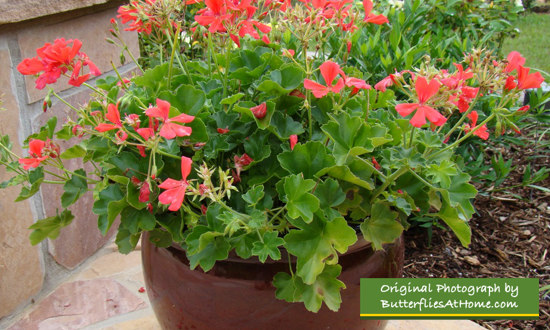 |
Marigolds ... an American favorite 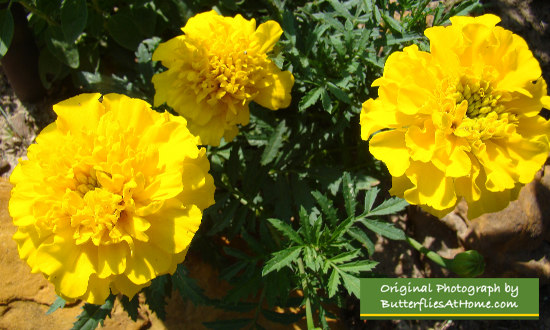 |
A bright, frilly Tulip in Spring |
Easy to grow Periwinkles 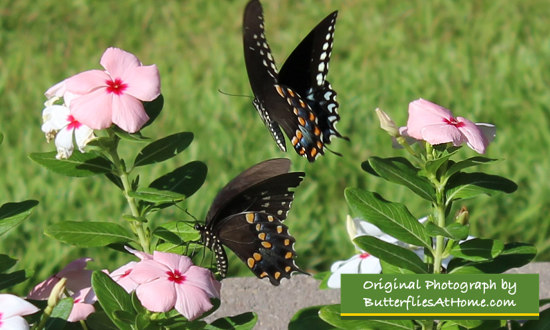 |
A Few More Flowers That We Enjoy in our Home Gardens!
An old favorite ... Flowering Almond 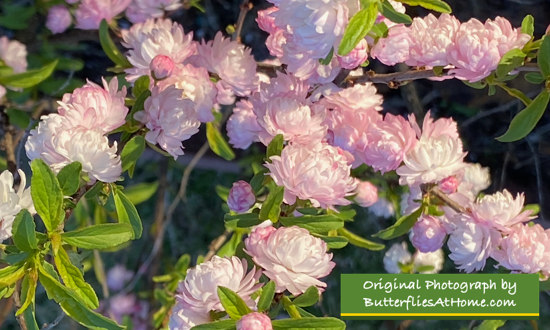 |
Agapanthus ... a lovely perennial 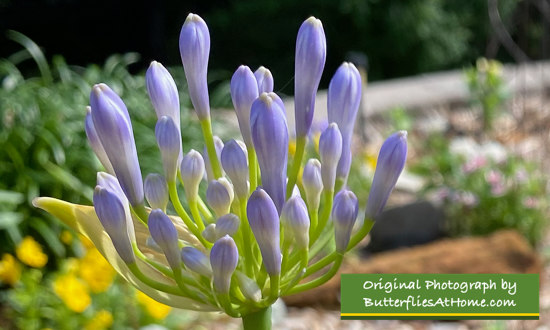 |
Pollinators & butterflies love Bee Balm |
Four o'clocks ... in the afternoon! 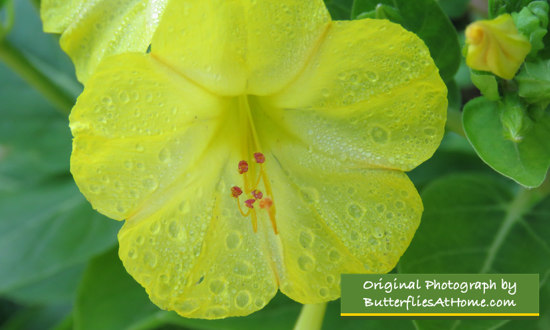 |
St. Francis of Assisi ... garden guardian!  |
Pink Torenia ... in a hanging basket 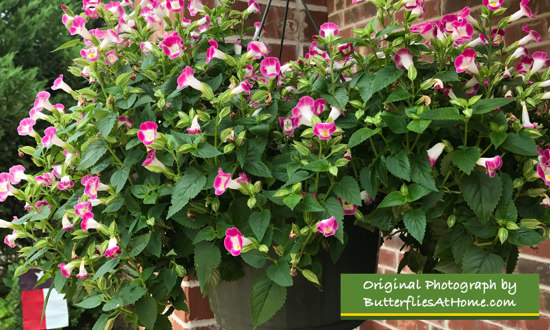 |
Not just butterflies in the garden!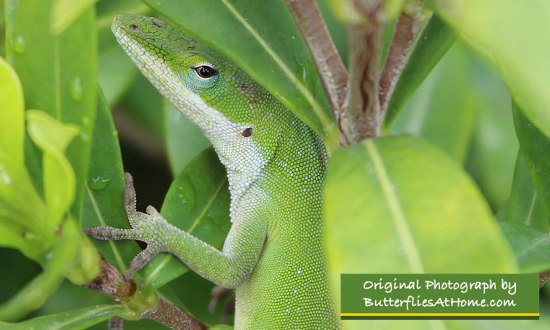 |
Ornamental Peppers 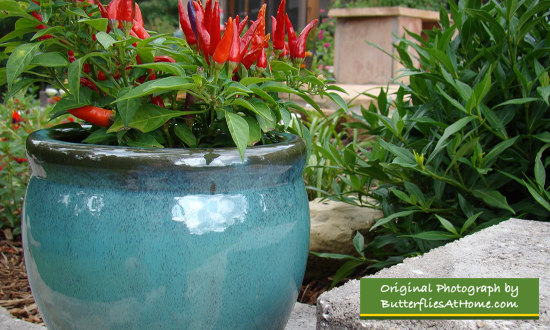 |
Spotted Bee Balm 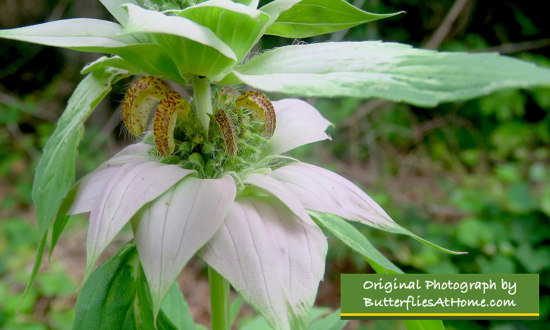 |
Butterfly Weed 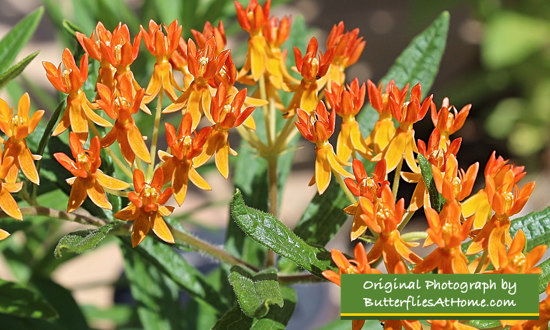 |
Need more help and ideas with your butterfly garden? Some popular books at our Amazon Store |
|
Gardening for Butterflies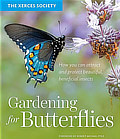 |
Butterfly Gardening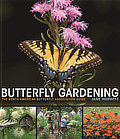 |
| Kaufman Field Guide to Butterflies of North America  |
Peterson First Guide to Butterflies and Moths of North America  |
The Life Cycles of Butterflies |
Stoke's Beginner's Guide to Butterflies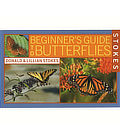 |
| About These Products
The Butterflies at Home website is a participant in the Amazon Services LLC Associates Program, an affiliate advertising program designed to provide a means for sites to earn fees by advertising and linking to Amazon.com and affiliated sites. Amazon offers a commission on products sold through their affiliate links. There is no additional cost to you. Orders are processed by and shipped via Amazon. |
| Hercules Club, or Devil's Walkingstick, a host plant for the Giant Swallowtail, growing in our woods 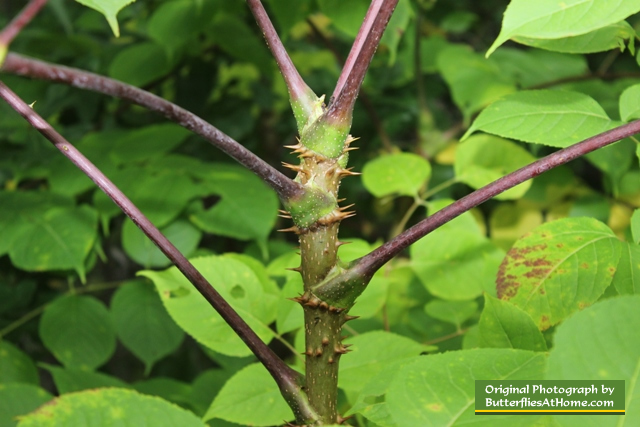 |
| A pollinator's dream! Vitex (Chaste Tree, Vitex agnus-castus) in full bloom in our landscape ... attracts lots of butterflies, bees and hummingbirds! 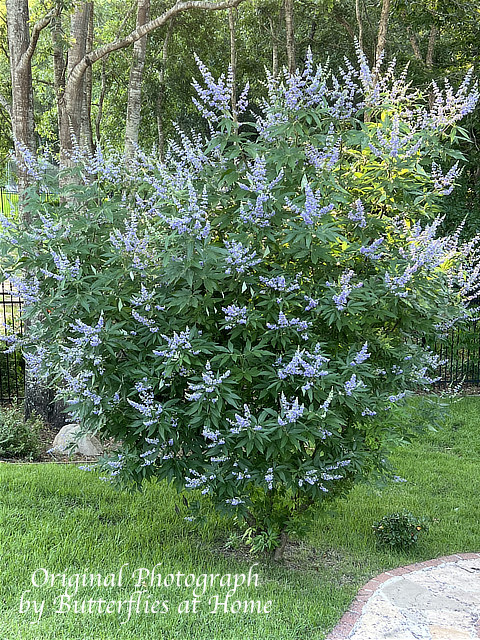 |
| Be sure to check out our other website ... HummingbirdCentral.com 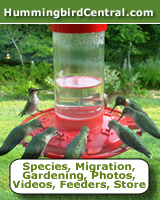 |
Hummingbirds love our garden too!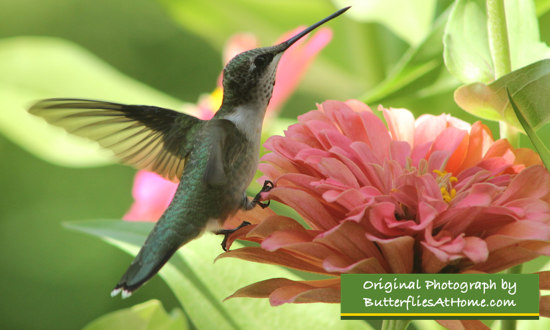 |
|
Learning from Public Butterfly Gardens
Another way to learn about gardening is to visit public butterfly gardens, parks and nurseries in your area.
Seeing what attracts butterflies at various gardens can help you plan and execute your butterfly garden. Be sure to read plant tags and identification markers for information about sun and shade requirements, soil, bloom times and other environmental needs of the plant.
Often docents or volunteers are available to give you their personal experiences and knowledge about various species that grow best in your local area.
View of the gardens at the Charlotte Rhoades Park Butterfly Garden in Southwest Harbor, Maine |
Square-bud Primrose flowers and identification sign. Lady Bird Johnson Wildflower Center
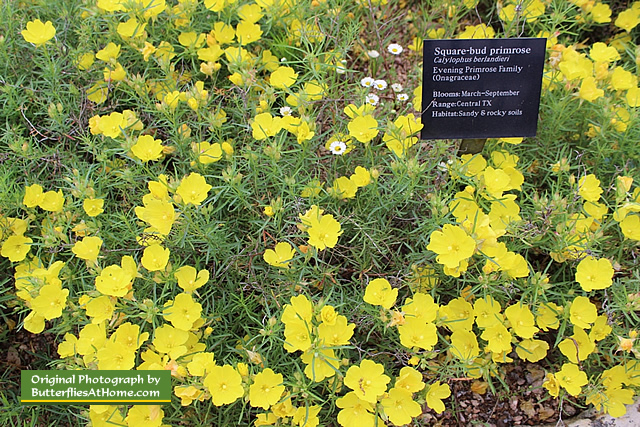 |
All Passion Vines are not purple ... here is a beautiful red Passiflora at Butterfly World in Florida |
Need butterfly gardening inspiration? Visit these beautiful gardens on our other website! |
||
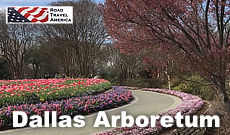 |
 |
 |

